|
. |
| About Us | Links | Photo Albums |  Forum | Humor | Site Ring | Ulithi E-Mail | Cards | Shop | Forum | Humor | Site Ring | Ulithi E-Mail | Cards | Shop |
| Bwang | Chant | Language | Legends | Mentors | Music | Mwarmwar | Navigation | Recipes | Tattoo |
Let us start with the legend of how Ulithi was formed...
A long time ago there were some sisters in Yap. One in particular loved eating turtle, but her
sisters would only give her the bad parts, like the fins. So she decided she was going to find
a place where she could eat all the turtle she wanted. She took a coconut cup filled with sand,
said some magic, then threw some sand ahead of her, which formed a strip of land that she could
walk on. She did this until she came to a spot where there were lots of turtles. By this
process, she formed the islands of Ulithi. She was happy at this new place because she could eat
all the turtle she wanted. After awhile her islet became overrun with ants and spiders, so she
lit a fire and used the smoke as a bridge to go to another islet. Here too she found it overrun
with ants and spiders, so again she lit another fire and walked over the bridge of smoke to the
islet of Mog Mog, where she settled. There is a platform there that was hers. It is the only
place in Ulithi where turtle may be killed.
Giil’ab and Yaaor are the Turtle islands. During March through June turtles come up onto these
islands even during the day. There are many fish there also. These islands are off-limits to
most people. They belong to a family on Falalop. If you want turtle or fish, you have
to ask permission. The islands where nobody lives still are owned by somebody. You cannot just go. If you
want something, you have to ask the owner.
On some islands the chief has to make the first cut on the caught turtle. On Ulithi atoll a
captured turtle has to be brought alive in front of the high chief on Mogmog, so that the he can
kill it symbolically by cutting it slightly, while the actual butchering is done later
(Lessa 1966:18). When the turtle is distributed it may happen that the man who actually caught
it will receive a rather meager share or no meat at all because the high chief can claim the
entire turtle. To disregard this tradition is a big insult. In disregarding it questions the
high chiefs position and what he stands for in the society; questioning the foundation of the
society. People know that they can only survive on these islands in the form of a
functioning community. The violation of any law is punished with serious sanctions. For example
when the remains of a turtle meal were found on the beach of Falalop, the marlül was told and
he placed a taboo on the entire beach of the island. People couldn't go into the water to
take their regular morning and evening bath, they could not use the sea for washing and cleaning,
men could not go fishing, visitors could not reach the island and its inhabitants could not
leave. Only after paying heavy fines in form of traditional valuables the taboo was lifted.
The severe reaction of the chiefs was a protection designed to protect the welfare of the
community from endangerment by the careless action of some of its members. Both events do not
represent the norm and, therefore, they are so well remembered.
|
|
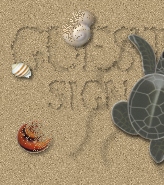 
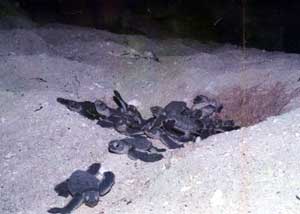
Turtle hatchlings coming out of nest
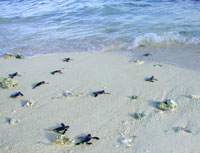
Turtle hatchlings going to shore
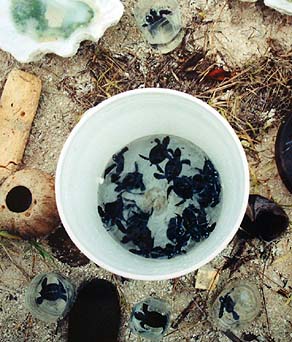
Turtle to be raised on West Fayu
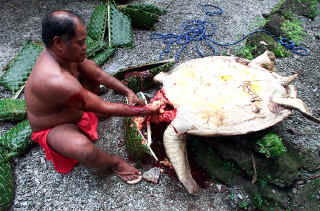
A caught female turtle being cleaned

Turtle being cooked |
|
Turtle is considered a delicacy. When a turtle waw captured the meat was spread amongst the
family. It was cooked on its back because there were no big pots before. Turtles have not only
cultural use but also medicinal use. The fats in the green turtle, mixed with fragrant flowers
like ilangilang, are preserved, and the old timers would use it for massage or for treating
painful areas. Another use would be to give young boys the blood of the turtle to drink.
The blood is medicinal also. When a young boy is emaciated, he was given it and he would expand.
To prepare the turtle for cooking; first a cut is made at the base of the throat and all the
entrails and eggs are pulled out through this incision. The eggs are a particular delicacy.
Mostly female turtles are caught when they come onto the beach to lay their eggs. Next the
turtle is placed upside down, still ‘whole’ but minus its innards; and a fire lit on its
underside using dry palm fronds. For fifteen minutes the turtle is kept in this position by then
the turtle is cooked and ready to eat.
Turtles normally hatch about 100 young, but only a few of them survive. Before when the
hatchlings come up, they were picked up and taken by boat out to the ocean and released
individually. That approach prevents predation. It starts on the beach from birds and land crabs.
Then those that are able to reach the water, there are young sharks awaiting them. The octopus
feed on them also, and very few would survive.
The federal government has listed green turtle as a threatened species and so it’s not
allowable to use them for culture, or use them for medicine. We continue to ask National
Marine Fisheries, U.S. Fish and Wildlife, to allow us cultural use. 10 turtles a year has been
requested to be harvested with the condition that 100 + young turtles will be raised a year.
U.S. Fish and Wildlife however want more data before granting such a request.
Resources:
www.pacificworlds.com, www.intangible.org, anthroglobe.ca, www.ms-startship.com |
|






